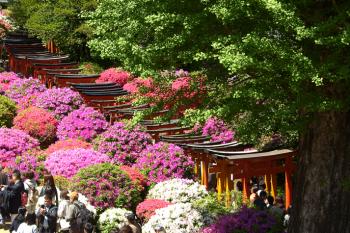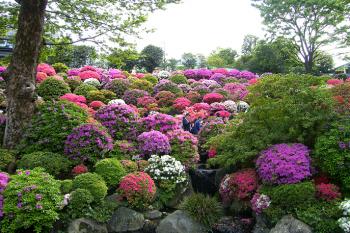Azalea festival in Tokyo
This item appears on page 34 of the April 2020 issue.
At the end of each of our annual Japan sakura (cherry blossom) visits, my husband, Clyde, and I look for more gardens with flowering plants as we return to the Ueno district in Tokyo’s Taitō ward.
In past years we visited the Fuji Matsuri, or Wisteria Festival, at the Kameido Tenjin Shrine in Tokyo’s Kōtō ward. It’s held during the last few days of April. We were last there in 2017, when I decided that I really don’t like the scent of wisteria and that the 2017 festival would likely be our last (Sept. ’17, pg. 16).
We visited Nezu Shrine, in Tokyo’s Bunkyō ward, in the autumn of 2018 with a Japanese friend we met through TripAdvisor.com. He told us to be sure to return to the shrine in late April or early May. He was so right!
On April 28, 2019, we went to the Tsutsuji Matsuri, or Bunkyō Azalea Festival, at Nezu-Jinja (Nezu Shrine). The festival included stalls for food, souvenirs, antiques and plants plus games, a Taiko drum performance, dance performances (including an elderly Japanese women’s dance troupe doing Hawaiian dances!) and, of course, azaleas.
The shrine has some 3,000 azalea plants of at least 100 different varieties. The shrubs were planted about 300 years ago. This 1,900-year-old shrine includes many separate buildings, each of which is designated as a national Important Cultural Property.
The compound has everything you’d expect in a Shinto shrine: torii (gateways), huge entrance gates with guardian statues, various halls and a stage, not to mention bridges and a koi pond.
The shrine is very photogenic, especially the small tunnel of torii, reminiscent of the much larger one at Fushimi Inari-taisha near Kyoto.
Even though we have seen Nezu-Jinja described as “Tokyo’s most beautiful Shinto shrine,” it is not one of the main tourist attractions in the city. In the autumn when we first visited, the three of us were the only people there.
Come spring, it’s a different story. Azaleas reign and visitors abound. We arrived early, and the line to enter the azalea garden was long but not impossible. When we left, mid-afternoon, the line was about a quarter-mile long, snaking its way through the temple grounds all the way out onto the main street, where a young monk was holding a sign, “Azalea End of a Line.”
Entry to the temple grounds was free, and entry to the azalea garden cost ¥200 (near $1.85). It was well worth it.
JANE B. HOLT
Hinesburg, VT


